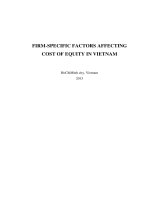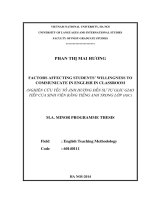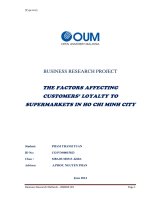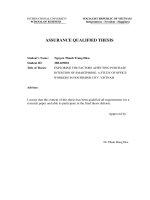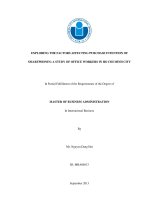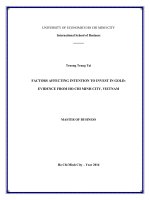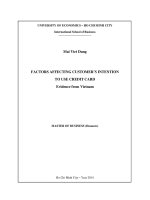Factors affecting learners intention to persist in e learning courses in vietnam
Bạn đang xem bản rút gọn của tài liệu. Xem và tải ngay bản đầy đủ của tài liệu tại đây (1.82 MB, 97 trang )
VIETNAM NATIONAL UNIVERSITY, HANOI
VIETNAM JAPAN UNIVERSITY
--------o0o--------
PHAM HUONG TRA
FACTORS AFFECTING LEARNERS'S
PERSISTENCE IN E-LEARNING COURSES
IN VIETNAM
MASTER’S THESIS
BUSINESS ADMINISTRATION
Hanoi, 2020
VIETNAM NATIONAL UNIVERSITY, HANOI
VIETNAM JAPAN UNIVERSITY
PHAM HUONG TRA
FACTORS AFFECTING LEARNERS'S
PERSISTENCE IN E-LEARNING COURSES
IN VIETNAM
MAJOR: BUSINESS ADMINISTRATION
CODE: 8340101.01
RESEARCH SUPERVISORS
PROF. DR. HIROSHI MORITA
ASSOC PROF. DR. PHAM THI LIEN
Hanoi, 2020
DECLARATION OF ACCEPTANCE
I am sure this is my own scientific study. The data used for the thesis have
undoubted sources according to guidance. The results of this research were
conducted by me, analyze truly and equitably follow Vietnamese situation.
The final conclusions are made as the results of study myself so they have not
been published by any other research group at any time other research.
Author
Pham Huong Tra
ACKNOWLEDGMENTS
I have to give my very first thank to my supervisors Prof. Hiroshi Morita and
Assoc Prof. Pham Thi Lien. I want to show my gratitude to Prof. Hiroshi Morita for
the sincere advises and engagement during the time I had seminars in Japan.
Moreover, I would thank Assoc Prof. Pham Thi Lien for her wise advises and
helping me to get to the right way when I met problem during the time doing this
research. Both of supervisors have inspired me a lot during my 2-year study period
in both Vietnam and Japan.
I also want to thank for all of Administrators, Training Department, MBA
program of VJU and YNU, the VJU –MBA03 class. Next, I have my thank to
everyone who spent their effort to complete a big step of my thesis.
Author
Pham Huong Tra
ABSTRACT
Vietnam is considered to be quickly catching up with the world trend because in
2010, when E-Learning started to become a global trend and spread to many
countries in the world, immediately after that, enterprises of the country has also
taken the first steps of exploring, launching a series of online learning websites such
as Violet.vn, Hocmai.vn, Topica, Onluyen.vn, Speakup.vn, Mathplay ... Up to now,
E-Learning has become a learning model that attracts a large number of users.
However, there has been no research in Vietnam on the factors affecting the
persistent intention to take an online course. There are 3 research objectives:
Investigating the predictors (demographic characteristics, internal and external
factors) that affect intention to persist in online learning courses in Vietnam, how
those factors influence each other and give recommendations for e-learning giver to
fascinate and keep students to complete the courses along with increasing business
performances. The study composed and expanded on the base of Rovai model with
adjusted of new aspect, internal academic locus of control. The Likert –scales 5
levels was used for 4 aspects: Internal academic locus of control, Satisfaction,
Support from family and work/school and Intention to persist. There are 10
hypotheses, however, 4 were denied after running data with Amos. More detail,
results of this research concluded that the gender and educational level show no
significant on students „s intention to persist in online learning courses. The
research also provided the structural equation modeling (SEM) of computing
variable value.
TABLE OF CONTENTS
ACKNOWLEDGMENTS ........................................................................................... 4
ABSTRACT................................................................................................................. 5
CHAPTER 1: INTRODUCTION ................................................................................ 1
1.1. Research motivation ....................................................................................2
1.1.1 Practical Motivation.................................................................................... 2
1.1.2 Theoretical Motivation ............................................................................... 7
1.2 Research Objectives......................................................................................8
1.3 Research Questions .......................................................................................8
1.4 Research methodology..................................................................................8
1.5 Research structure .......................................................................................10
CHAPTER 2 LITERATURE REVIEW .................................................................... 11
2.1. Definition ...................................................................................................11
2.1.1 Distance Education ................................................................................... 11
2.1.2 Dropout ..................................................................................................... 13
2.1.3 Persistence ................................................................................................ 14
2.2 Research Model Literature Review ............................................................14
2.2.1 Psychological models of persistence ........................................................ 14
2.2.2 Tinto’s student integration model ............................................................. 16
2.2.3 Bean and Metzner’s student attrition model ............................................. 19
2.2.4 Rovai ’s composite persistence model ...................................................... 22
2.3 Research Hypothesis ...................................................................................31
2.3.1 Demographic characteristics ..................................................................... 31
2.3.2 Internal factors .......................................................................................... 35
2.3.3 External factor........................................................................................... 38
2.4 Research Model Proposed ..........................................................................40
CHAPTER 3: RESEARCH METHODOLOGY ....................................................... 42
3.1 Research Process ........................................................................................42
3.2 Data collection method ...............................................................................43
3.2.1 Primary data source .................................................................................. 43
3.3 Data Analysis Method ................................................................................49
3.3.1 Comparative meta-analysis method:......................................................... 49
3.3.2 Methods of statistical analysis and impact assessment ............................ 49
CHAPTER 4: RESEARCH FINDINGS ................................................................... 50
4.1 Descriptive Analysis ...................................................................................50
4.2 Cronbach’s Alpha Analysis ........................................................................50
4.3 Factor Analysis ...........................................................................................53
4.3.1 Exploratory Factor Analysis (EFA) .......................................................... 53
4.4 Confirmatory Factor Analysis ....................................................................56
4.4.1 Testing the suitability of the model .......................................................... 57
4.4.2 Assess the reliability of the scale .............................................................. 57
4.4.3 Convergent validity .................................................................................. 58
4.4.4 Unidimensionality..................................................................................... 59
4.4.5 Discriminant validity ................................................................................ 59
4.5 Structural Equation Modeling (SEM) .........................................................61
4.6 Revised Research Model ............................................................................65
4.7 Hypothesis Testing Results.........................................................................66
CHAPTER 5: CONCLUSIONS AND RECOMMENDATIONS............................. 67
5.1 Conclusion and discussion ..........................................................................67
5.2 Recommendation ........................................................................................70
5.3 Limitation and future research ....................................................................72
APPENDIX ................................................................................................................ 83
LIST OF TABLES
Table 2.1 Table comparing research models of persistence ...................................... 25
Table 2.2 Dropout/Persistence factors from past empirical studies .......................... 25
Table 3.1 Research process ........................................................................................ 42
Table 3.2 Scale Description Table ............................................................................. 44
Table 4.1 Item statistic of intention to persist variable .............................................. 51
Table 4.2 Cronbach's alpha ........................................................................................ 52
Table 4.3 KMO and Bartlett's Test ............................................................................ 54
Table 4.4 Eigenvalue and variance explained ........................................................... 54
Table 4.5 Pattern Matrix ............................................................................................ 55
Table 4.6 Composite reliability, Average variance extracted and Correlation ......... 57
Table 4.7 Regression weights and standardized regression weights ......................... 58
Table 4.8 Assessment of Discriminant validity ......................................................... 59
Table 4.9 Analysis results of SEM linear structure model ........................................ 63
Table 4.10 Direct, Indirect and Total Effect relationships ........................................ 64
LIST OF FIGURES
Figure 2-1 Theory of reasoned action (Ajzen, 1975) ................................................ 15
Figure 2-2 Conceptualization of (Tinto, 1975,1987,1993) ‘s student integration
model .............................................................................................................................. 17
Figure 2-3 Conceptualization of (Bean, 1985) student attrition model ..................... 20
Figure 2-4 (Rovai, 2003) ‘s composite persistence model ........................................ 23
Figure 2-5 Revised Rovai’s composite persistence model with internal academic
locus of control variable and the correlation between internal and external factor
(Author) .......................................................................................................................... 40
Figure 4-1 CFA model on Amos ............................................................................... 56
Figure 4-2 Analysis results of SEM linear structure model ...................................... 62
Figure 4-3 Revised research model (Author) ............................................................ 65
CHAPTER 1: INTRODUCTION
Online learning has been around for a long time and it attracts many people, not only
students but also professionals. This is simply because it offers flexibility in study time,
easy access (when connected to the internet) and convenience everywhere. In past
years, e-learning has certainly been the quickest growing major in education due to the
quantity of users and market profits of the related field. The demand for e- learning
programs and products have exceeded more than $27.1 billion globally in 2009, and is
expected to hit $49.6 billion by 2014 (Ambient Insight Research, 2010). (Allen, 2013)
estimated that the number of students who completed at least one e-learning course in
the fall semester in 2012 were more than 6.7 million students, accounting for 32% of
the total amount of university graduate. Nowadays, the fact is technology improves day
by day, so that will enable online classroom simulation and the need for lifelong
learning, the growth of online learning will be very clear. Therefore, online learning,
regardless of language courses, soft skills, professional knowledge, needs serious
attention from educational investors and lecturers.
While an obvious increase in student enrollment in online courses can be clearly
seen, the commitment in these courses is usually much smaller than conventional
classrooms, face-to-face programs ( (Carr, 2000); (Jun, 2005); (Rochester, 2008)).
According to a study, the percentage of students who left e-learning courses that they
registered was from 10% to about 50-75%( (Carr, 2000); (Jun, 2005); (Rochester,
2008)). Some e-learning study showed that learners „s fallout experiences lead to
frustration and reduced their confidence or independent and this may make them not
want to register others online course (Poellhuber, 2008). From that, somehow, they can
be isolated from the society and more seriously, it will influence economic losses
(Rumberger, 1987). Therefore, administrators want to encode and classify factors
affecting dropout or persistence to minimize debilitation. (Diaz, 2002)
1
1.1. Research motivation
1.1.1 Practical Motivation
Online education (E-Learning) model first appeared in the world in the US in 1999,
opening a new learning environment for learners to interact via the Internet on media.
electronic communication. However, it was not until 2010, when applications on
mobile platforms and social networks (Facebook, Google Plus, Instagram ...)
developed, bringing interoperability anytime, anywhere for users. New E-Learning
trends really spread around the globe. To date, E-Learning has put its name on the map
of the world's most vibrant industries. According to The Economist, the number of ELearning participants in the world has increased rapidly from about 36 million in 2015
to 60 million in 2016 and reached nearly 70 million in 2017. The number of users is
constantly increasing. Up has led to an increase in the revenue of this industry. Data
from the 19th global meeting on "Application of information technology and
management - ITAM" held in 2018 in Vietnam said: In 2016, worldwide E-Learning
revenue reached the figure is quite impressive at 51.5 billion USD. By 2017, the global
online education market has grown by leaps and bounds, reaching more than US $ 100
billion (research results of Global Industry Analysts).
E-Learning is the most active in the US, the country with the world's top education.
As shown by the statistics of Cyber Educational Institution in 2018, more than 80% of
the country's universities use E-Learning training method. There are many businesses
offering MOOC (Massive Online Open Coures) - the most famous MOOC service,
which can be named Coursera, edX and Udacity. ... E-Learning is also considered as an
effective staff training channel when up to 77% of companies in the US put E-Learning
courses into their employee training and retraining programs.
Besides the US, Asia is also a market that offers quite "E-Learning" services.
According to the University World News, the region's total E-Learning revenue in
2
2018 was about 12.1 billion USD, of which India and China were the two leading
countries, accounting for 70% of the capital. venture capitalists and 30% of all online
educational users worldwide. In the Chinese market, in 2018, the revenue of the ELearning field reached $ 5.2 billion. Although the economy of the neighboring country
has shown signs of decline from the end of 2018 to the present due to the impact of the
US-China trade war, the economic community said that E-Learning is still very
developed to make up for the shrinking of a number of domestic manufacturing
industries. Although not achieving big revenue like China, India is also a country with
developed E-Learning with revenue of 0.7 billion USD in 2018. Prominent in the
Indian E-Learning market is BYJU (a-single startups provide online learning
applications for K-12 students) thanks to the attractive online learning applications for
people in this country and many other countries. According to the report of the World
Financial Organization (IFC) in 2018, from the launch date in October 2015 to 2018,
BYJU's online learning application has covered more than 1,700 cities in India and
other countries. in the Middle East with more than 15 million app downloads and
nearly 1 million paid users annually. As of 3/2018, BYJU's revenue has reached 85
million USD and attracted more than 245 million USD investment since 2016. (Linh,
2020)
Vietnam is considered to be quickly catching up with the world trend because in
2010, when E-Learning started to become a global trend and spread to many countries
in the world, immediately after that, enterprises the country has also taken the first
steps of exploring, launching a series of online learning websites such as Violet.vn,
Hocmai.vn, Topica, Onluyen.vn, Speakup.vn, Mathplay ... Up to now, online learning
has become a studying model that attracts a large number of users, chiefly in busy and
developed places like Ho Chi Minh City, Hanoi and Danang with a wide coverage of
students, from students at all levels to study. Online education activities in Vietnam
mainly provide service groups as follows: Language classes in international languages;
3
Test preparation courses / specialized knowledge lectures (level 2, level 3) and skill
courses. The content of E-Learning lectures is quite rich, designed and integrated in
many different forms of expression such as videos, clips, sound effects, vivid
illustrations ... but still ensures interaction with teacher. Particularly for programs for
high school students at all levels, many online learning sites provide a database of
thousands of lectures designed to closely follow the curriculum of Educational
Ministry
According to the Vietnam labor market update in the first quarter of 2019, the
country had more than one million people of unemployed age, of which 124,500
people have university or higher degrees. Therefore, the need to learn more foreign
languages or soft skills is very high for students and employees to increase
competitiveness when applying for a job. People will often choose online courses to
take advantage of both work and study because compared to going to a classroom,
online learning is much more convenient. Of course, for students, price is a very
important factor. Usually online courses are chosen by students because they are
cheaper than going to classes.
An online channel that is familiar to Vietnamese users is hocmai.vn of Hocmai.vn
Education System. After more than 10 activities, website hocmai.vn has attracted 3.5
million members to join with over 10,000 visits and concurrently study; provides more
than 1,000 courses, 30,000 lectures per year for more than 200 teachers on computer
devices, laptops, phones ... According to the latest 3 years of this system, the
percentage of new users registered on the online learning system of the unit has
increased by nearly 20% per year, of which the percentage of learners paying fees has
increased by more than 30% per year. This shows that the trend of users using ELearning at hocmai.vn is still increasing.
4
Along with hocmai.vn, Topica Educational Technology Complex is also an address
chosen by thousands of users to study with various online education solutions such as:
Online Bachelor Program (Topica Uni); Learning English online (Topica Native); The
technology platform for online courses is open in many areas (Edumall). Last year,
Alipay made a contract with Napas to link the two networks. Vietnamese marketplace
is quickly followed by the arrival of hundreds of companies from Asian especially
from Japan, and investment from domestic and foreign financial firms.
It is noteworthy that E-Learning is not only attracting the investment interest of
businesses but also a trend chosen by the Vietnamese education industry. Specifically,
the Ministry of Education and Training has cooperated with businesses to deploy ELearning and online exams in the country such as the contest "Designing E-Learning eLearning lectures" in 2009-2010 school year or online math contest at violympic.vn
website; English Olympic Games on Go - ioe.go.vn ... Many universities in the country
also gradually apply E-Learning model besides traditional education method in
educational program. For example, Nguyen Tat Thanh University, Polytechnic
University,... In addition, there is the appearance of universities in Vietnam. Online
training is FUNiX, a member of FPT Education system.
Vietnam is perceived to be a promising marketplace for E-Learning growth because
more than 60% of the population uses the Internet, the majority of the users are young
people with high learning needs, and spending on education accounts for 5, 8% of GDP
and 20% of total budget expenditure (data of the Ministry of Education and Training).
Therefore, E-Learning is no longer a playground for familiar names emerging from the
early days of development, but also attracts the participation of many Vietnamese
startups and foreign investment sources, especially businesses from Singapore. At the
end of 2016, Vietnam had 309 funding ventures in E-Learning with a combined
reported equity of more than $767 million. Capital inflows into the market are expected
to continue to increase in the following years.
5
Northstar Singapore Group decided to pour capital into Topica Edtech Group with an
investment of up to $ 50 million at the end of November 2018. This is the largest
funding for an educational technology corporation in Southeast Asia. Kaizen Private
Equity, an educational hedge fund Singapore and India based, revealed at the
beginning of August 2019 that it will pay $10 million in Yola, a start-up that offers elearning English teaching facilities in Viet Nam. Shortly thereafter, at the end of
August 2019, Everest Education, a Vietnamese startup in the educational sector started
raising well $4 million from the Hendale Capital-based in Hong Kong (China). This
funding is used to finance the development of the company's academic training centers
in Ho Chi Minh City using an integrated blended studying approach that mixes
conventional classroom studying and learning with new method online learning
(Mobile and Internet Studying).
The presence of domestic companies and foreign investors has made the E-learning
market in Vietnam grow and put Vietnam among the top 10 rapidly developing Asian
countries in this field (according to Statistics of University World News, 2017). Also in
2017, Vietnam was ranked as the nation with the fastest growth rate (about 44.3%) of
e- learning, 4.9% larger than Malaysia - an already inherently accelerated country
which is strong growth in this area.
In addition to the above-mentioned potentials of Vietnam for online learning, a recent
external factor has also greatly influenced the online learning situation in Vietnam.
Since the Tet holiday, on January 30, 2020, Vietnam has detected the first 3 cases of
corona virus. The virus has so far been declared a worldwide pandemic by WHO. The
government announced the closure of schools at all levels from primary to tertiary and
graduate. With the extended period of absence, many schools have shifted to online
teaching. Because of that, many centers for teaching foreign languages or soft skills
have also turned to online courses. Around the world, Harvard University has opened
more than 60 free online courses accessible to everyone. Sixty online courses in data
6
science, programming, social sciences, anthropology, health and the arts. There are
also more free online courses from: British Council, Microsoft, Yale University
,....During the time when the pandemic was serious, all residents were encouraged to
stay indoors and to limit going out. Therefore, the demand for learning and improving
knowledge during free time at home is increasing. Everyone has time and material to
study online. During the pandemic and even after this pandemic, online learning may
take a huge developed step for both education and economic field.
Although Vietnam has the potential and opportunities for online learning
development, the percentage of people who dropout online courses is still high. It
seems that the courses are many in number but not quality assurance. So that the
question here is what is the reason why students make the decision to quit or continue
to study online courses. This study may serve to recognize influences that affect the
intention to persist an online course in Vietnam.
1.1.2 Theoretical Motivation
From the theoretical point of view, this study would include an analytical analysis of
the current dimension, internal academic locus of control and re-testing the Rovai‟s
composite persistence model with an updated model. In Rovai‟s composite persistence
model, it shows learners ‟s aspects and external aspects affect persistence through
internal aspects, which means they don‟t directly affect to persistence of students.
However, this research will prove the direct effect of external aspects to persistence.
Also, currently, no specific study paper on the aspects influencing the decision to
persist in online courses in Vietnam is found. While in the world there are relatively
many researches on this issue. However, the previous studies on students' perseverance
only compared the differences between the influencing factors, they defaulted the
influence of those factors on perseverance and only studied the differences in the
impact with dropout and persevering students Especially in Vietnam, people tend to
worship before exams, so the internal academic locus of control, is a decisive
7
predictable aspect in this research model. “Locus of control is the belief that the
outcome of one's actions depends on what one does (internal control points) or on
events outside of self-control (external control points)”. (Psychologist Philip Zinbardo)
1.2 Research Objectives
As mentioned in the practical and theoretical motivation above, there are 3
research objectives:
-
Investigate the factors affecting learners ‟s intention to persist in e-learning
courses in Vietnam.
-
Investigate how those factors affect learners ‟s intention to persist in online
learning courses in Vietnam.
-
Propose suggestions and solutions for high rate of dropout to attract more
learners and keep them to persist with online courses also improve online
learning business performances.
1.3 Research Questions
Base on research objectives listed above, there are two research questions:
-
Do demographic characteristics (age, educational level, gender), external factors
(support from family and work/school), and internal factors (internal academic
locus of control and satisfaction) affect the learners ‟s intention to persist in elearning courses in Vietnam and its relationship?
-
What aspects and recommendation for e-learning business in order to keep and
get more learners, improve online learning business performances?
1.4 Research methodology
This thesis used primary data sources collected by the surveys to figure out the
kernels aspects can influence the intention to persevere in online courses in Vietnam.
8
Quantitative analysis was applied in this research. In that way, primary data collection
is possible proceed as follows:
The surveys were assigned among Vietnamese people living in Vietnam by Google
Form. The object of study is the people who are over 20 years old and studying online
courses (Language, Soft skill, Coursera, Professional ,..) at the time doing the survey.
The surveys were released from 5th April to 20th April, 2020. The delivery networks
were online only.
Information gathered from the study will be circulated investigation and taking care
of in the accompanying request:
- Input: The questionnaire was entered using data entry software for research to
avoid bias.
- Clean the data: Data is cleaned by screening data through 2 steps: identifying
errors - checking for errors to see if they are within the allowed range, then correcting
errors in the file - finding and correcting the error in the data file.
Information gathered has examined with Amos 24 and SPSS 22 which combine:
- Descriptive statistics analysis: using descriptive statistics analysis to unmitigated
analyze in age, educational level and gender.
- Reliability analysis: use Cronbach‟s alpha and exponential factor analysis to test
the reliability.
- Confirmatory Factor Analysis
- Factor loading analysis.
- Structural Equation Modeling
9
1.5 Research structure
This study formulates a model, of factors affecting learner's intention to persist in elearning courses in Vietnam. This research is divided into 5 fundamental chapters
including introduction, literature review, research methodology, finding and
conclusion.
Chapter 1: Introduction
This chapter gives an introduction of research motivation, research object, research
question, research methodology, research structure.
Chapter 2: Literature review
This chapter provides the summary and reviews existing research related to literature
of e-learning and factors affecting learner's persistence. Based on that, author proposed
research model and research hypothesis.
Chapter 3: Research methodology
In this chapter, research design, data collection process and information investigation
strategies were utilized to gauge the model proposed in chapter 2.
Chapter 4: Research findings
This chapter demonstrated examination results was broke down from information
assortment.
Chapter 5: Conclusion
This chapter discussed about exploration discoveries then propose thẻoetical and
practical contribution. Also, the constraint just as future exploration direction was
appeared in this chapter.
10
CHAPTER 2 LITERATURE REVIEW
2.1. Definition
2.1.1 Distance Education
According to many scholars in the world, "Distance education is a teaching
process education – studying in which most or the entire educational - studying process
has the separation between teachers and learners in space and time” (Wikipedia).
Distance education follows (Schlosser, 2009) as "Institution-based, formal education
where the learning group is separated, and where interactive telecommunications
systems
are
used
to
connect
learners,
resources,
and
instructors‟‟.
This
description/definition has been generally acknowledged. Distance learning is well
described by four components in Encyclopaedia Britannica 2009 Book of the Year:
(1) Distance learning is conducted via education systems, it isn‟t studying by
yourself or learning in an environment without academic. Whether institutions can
teach based on traditional classes, but they need to meet the qualifications to be
recognized as traditional teachers.
(2) Geographical segregation still exists in distance learning, and a time element is
also likely to affect students and teachers due to different time zones. At that time,
accessibility and convenience are important advantages with this distance education
method. With well-designed programs, cultural, intellectual and social differences
among students will be connected.
(3) Telecommunication is an interaction bridge between learning groups and
teachers. In addition to the electronic forms of communication, such as email, which
are still used, conventional communication way like post or telecommunications play a
small role also. So that, whether it is any method, modern or traditional, it is necessary
to serve demand of distance education. Connection between teachers, teaching
11
materials and students also becomes less dependent on the physical distance effect
because the communication system is very developed and can quickly provide any
document. In general, the internet, mobile phones, and email have made a significant
contribution to distance education.
(4) Distance learning, like conventional classroom, also establishes a group to study
or can be called a studying association including teachers, students, teaching materials
such as slides, sounds, video and graphics, etc., allowing students to access instruction.
(Simonson, 2009a)
Although distance learning is still used to teach elementary or high school students
communication, but distance learners are mostly adults studying programs University.
Adult students often choose to study distance to expect to have enough degree to work
and get promoted, and to be able to learn for a lifetime and still not suffer bound by the
responsibility of a full-time study or not restricted by distance from where you need to
study (Columbaro, 2009).
The advantages of distance education are widely well known. Firstly, distance
education supports the accessibility of national education system, creating
opportunities for those in need constraints on time, location, economic circumstances,
age, level of access to knowledge. This flexible, flexible form of training facilitates
learning and education for everyone. Secondly, for individual learners, distance
learning helps students save time because they do not need to move to school; Students
are allowed to study according to a customized schedule according to their situation. In
addition, with knowledge and information changing rapidly, professionals can keep up
to date with new knowledge without having to travel far to specialized training courses.
With online courses, lecturers also do not need to move and can teach at home. The
third benefit of this form of learning is cost savings. Travel expenses for students as
12
well as lecturers can be saved. Different institutions may have the same lecturer, with
online courses lecturers can teach more people.
Besides the above advantages, distance learning also has certain limitations. The
quality of distance studying is concerned to be the first limitation. Because the class
quality depends on the attitude of management and lecturers. Often the attitude of the
manager watching distance learning as a second-class form of training, and the
instructor thinks that when we use distance studying, usually the quality is less than the
quality of the traditional classroom, so they do not try to adjust the training program or
lecture accordingly. Teaching distance and accepting the ease in training. Besides,
when teaching lecturers, it is difficult to adjust lectures in time depending on the
situation due to not having direct contact with students, and this may affect learning
outcomes. episode. It is because this is not really connected that will adversely affect
the learning process student internships (Valentine, 2002).
The second is the issue related to the learner. Not all students are suitable for this type
of study. When studying from distance, students may have difficulty in knowledge
related to technology, science or quantification. Distance learning students who want to
succeed need a few personality traits like the willing to accept ambiguity and the
capable of being flexible. Compared to regular students, the requirement for distance
education learners is more focusing, well time management, knowing how to use
technology, capability of working individually and working in groups. An independent
learning environment can make learners less focused and afraid to learn. The exchange
of information with teachers, friends mainly via the internet and phones, can make
learners understand lessons incompletely and feel bored. This solitary state also causes
learners to become less active, less confident and less motivated to learn.
2.1.2 Dropout
13
No specific definition of dropout has been explained in detail. However, some
authors focus on students' positive behaviors to draw definitions. (Levy, 2007) argues
that people who dropout are willing depart from an e-learning course because they pay
an additional penalty after a period of abolition or extra payment. Some authors
suggest that a simple dropout is defined as not completing a course, being assessed
based on a final student assessment, an incomplete or a final "F". (Liu, 2009)
2.1.3 Persistence
Persistence can be understood as the willingness of learners to keep on going and
continue to accomplish studying ambition, or to continue/remain to involve in
academic courses (Shin, 2003)
Persistence is widely known as an opposite meaning of attrition or a continuum of
components that finally get to the accomplishment of a program (Park, 2009). The
word persistence was well-known first time in 1980, in regard of secondary education,
when persistence was simply explained as leaving conventional universities (Greer,
1980) . (Berger, 1998)use returning intention as a way to measure perseverance for
freshman in traditional classrooms. So that, in my study, persistence will be considered
a multifaceted phenomenon that leads to the completion of online learning. The
intention to persist is the intention to complete the course that the student is attending
at the time of taking the survey.
2.2 Research Model Literature Review
2.2.1 Psychological models of persistence
A variety of theoretical models of student perseverance have been researched and
emerged in many countries over the last few decades. The earliest model to explain
persistence is the psychological model. Theory of reasoned action (Ajzen, 1975), for
example, hypothesized that students' persistence decisions were primarily focus on
14
prior actions, perceptions and expectations which become real behavior by the
development of an intention to study.
Figure 2-1 Theory of reasoned action (Ajzen, 1975)
(Corno, 1993) found that between learning intentions and learning behavior, there is
an intermediate force called volition. Thus, volition was known like behaviors and
feelings which are geared at sustaining the purpose to accomplish a particular target
when affected by distractions. (Heckhausen, 1985) defined volition as a psychological
condition influenced mostly by notion of translating aspirations to practical actions
then emphasizing how importance self-regulation is when we consider about
perseverance. We also recognize that motivation is an essential driver for students to
participate in studying courses, however, the one in courses that demand constant
commitment will be less motivated if they encounter the difficulties. So then, the
volition process will be an important factor in the analysis of perseverance.
Later, also based on these psychological models, more models were created to
explain persistence and dropout through observations from students, external factors
and variables specific topics between campus life and the social inclusion of students.
The model of two authors (Tinto, 1975,1987,1993) and (Bean, 1985) were two typical
models and were used a lot to explain this genre.
15
2.2.2 Tinto’s student integration model
Shown in (Fig.2-2), model of (Tinto, 1975,1987,1993) has shown that from the
student-institution, process of components affecting student perseverance has been
explained very specific. Tinto hypothesized that in order to lead to success in academic
perseverance, the key factors to be considered were: (1) factors drawn from the
experience of individual personality in general and university students in particular. (2)
Factors drawn from experience gained in university. Pre-university experience and
student personality are considered input variables, these variables are virtually
unaffected by the school. However, the experience gained after students enroll, what
Tinto calls "integration" variables will often be influenced by the school such as policy.
(Tinto, 1987) showed that ''The more central one's membership is to the mainstream
of institutional life the more likely, other things being equal, is one to persist''. Lower
secondary school indicates scholastic convergence has a significant effect on
perseverance (Pascarella, 1991). Thus, when considering and assessing whether a
student is suitable for a school or not, people often rely on perseverance.
16
